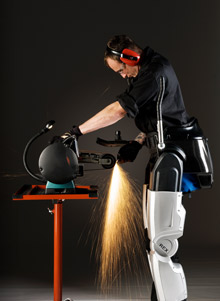
Engineer Hayden Allen has used a test version of the Rex device to work more safely with power tools in his machine shop. Photograph courtesy of Rex Bionics.
When New Zealand engineer Hayden Allen sustained a spinal cord injury in 2005, he became a full-time wheelchair user, and doctors told him he’d never walk again. Today, however, he spends part of his day standing and walking thanks to Rex, a robotic exoskeleton developed by Auckland, New Zealand-based Rex Bionics. Like the Argo company’s ReWalk the Rex is designed to support and assist a wheelchair user in standing, sitting, walking, and going up and down stairs and slopes. Allen has been among the first testers of the device, which consists of a pair of robotic legs, a harness, a controller, and a power pack.
“I’ll never forget what it was like to see my feet walking under me the first time I used Rex,” the six-foot, four-inch tall Allen said. “People say to me, ‘look up when you’re walking’ but I just can’t stop staring down at my feet moving.”
The device is the brainchild of two childhood friends, Richard Little and Robert Irving, the co-founders of Rex Bionics.
“Both of our mothers are in wheelchairs, so we are aware of some of the obstacles and access issues faced by many wheelchair users,” Little said. Irving was diagnosed with multiple sclerosis (MS) in 2003, which the company says was the catalyst for the two men to put their engineering skills to use to develop a practical standing and walking alternative to wheelchairs.
The founders are quick to point out that Rex is not a replacement for a wheelchair, but a complement that offers a range of options not currently available anywhere else in the world. It is potentially suitable for manual wheelchair users who can self-transfer and operate hand controls. Rex users self-transfer from their wheelchair into the 84-pound device, strap themselves in, then control their movements using a joystick and keypad. Rex is powered by what the company calls a “lightweight, long-life rechargeable battery” that is designed to last for a typical day of use. According to Rex Bionics, being out of their chairs and on their feet again could provide Rex users many more lifestyle options, increasing their opportunities for employment and recreation.
Richard Roxburgh, MD, an Auckland neurologist and a medical adviser to the Muscular Dystrophy Association, commented, “Rex represents the first time [some of my patients have] been able to stand up and walk in years. There are obvious immediate benefits in terms of mobility, improved social interaction, and self-image. There are also likely to be major long-term health and quality of life benefits through reducing the complications of being in a wheelchair all the time. I think that this will also enable people to stay well longer; this means that those who have conditions where disease-modifying treatments are coming over the next five to ten years will be in better shape when those treatments finally arrive.” Potential wearers must complete a medical appraisal including checks with their own physician to ensure their general health and suitability before they can begin the two-week process of fitting and training on the device.
According to Rex Bionics, the Rex project is now in its final stages of testing after a seven-year development process that has included engineering validation and clinical trials with the approval of the New Zealand Ethics Committee, in conjunction with disability and rehabilitation advisors. It is expected to be available for purchase in New Zealand in late 2010 and in other countries in 2011. Pending U.S. Food and Drug Administration approval, it is expected to cost about $150,000 in the United States.




